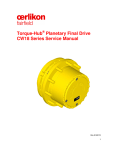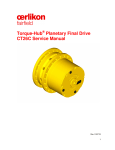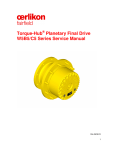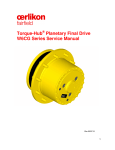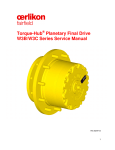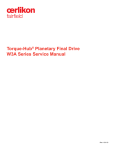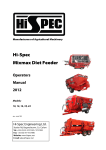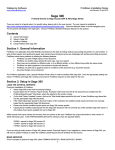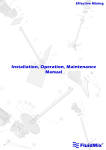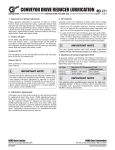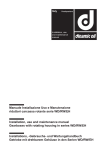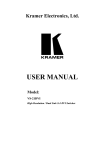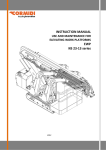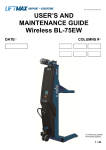Download Torque-Hub® Planetary Final Drive CW130 Series Service Manual
Transcript
Torque-Hub® Planetary Final Drive CW130 Series Service Manual Rev 01/30/2014 While every precaution has been taken in the preparation of this document, Fairfield Manufacturing Co. Inc. assumes no liability with respect to the use of the documentation described herein, or for any act or omission of Fairfield Manufacturing Co. Inc. concerning this documentation. Torque-Hub® is a registered trademark of Fairfield Manufacturing Co. Inc. Features and specifications are subject to change without notice. 1 Planetary Final Drive Service Manual Content Introduction Brake Test Roll and Leak Test Tightening and Torquing Bolts Lubrication Information Face Seal Installation 3 5 7 9 10 13 Disassembly Instructions Main Disassembly Cover Disassembly Housing-Spindle Disassembly Input Brake Disassembly Output Carrier Disassembly Input Carrier Disassembly 17 19 20 23 24 25 Assembly Instructions Cover Subassembly Input Carrier Subassembly Output Carrier Subassembly Housing-Spindle Subassembly Main Assembly Input Brake Subassembly Input Assembly Parts List Assembly Tools 27 28 29 31 33 35 37 39 41 General Information Contact Information 48 2 Planetary Final Drive Service Manual Introduction This manual is a step-by-step guide to the disassembly and assembly of the CW130 Torque-Hub® units. It is designed for the customer or mechanic who is repairing this particular Torque-Hub® model. Users of this manual should note that each part mentioned is followed by an identification number enclosed in parentheses. These part numbers may be referred to in the Parts List and Assembly Drawing sections of this manual. Specialized tools used to assemble this unit are noted in the assembly procedures and diagrammed in the Assembly Tools section. Users should familiarize themselves with the procedures for roll and leak testing, as well as bolt tightening and torquing found on the following three pages before starting any repairs. Standard safety practices should be followed during the disassembly and assembly procedures described. Safety glasses and safety shoes should be worn, and heavy, heat resistant gloves should be used when handling heated components. Be especially alert when you see the word CAUTION. This indicates that a particular operation could cause personal injury if not performed properly or if certain safety procedures are not followed. The word NOTE is used to bring attention to certain procedures or helpful hints that will aid in the disassembly and assembly process. 3 Planetary Final Drive Service Manual Brake Test The Brake Test To perform a brake check, use a M12x1.5 metric fitting. Install a hydraulic hand pump with pressure gauge into brake port in spindle (1A) using metric thread fitting. Place ROLL TEST Tool (refer to table on page 9) into input coupling. Apply 10 in-lbs torque. While trying to rotate tool, pump the handle on the hydraulic hand pump and increase the pressure until the brake releases. The brake is released when you are able to rotate the tool. Record the release pressure. If the brake does not release within limits shown in the brake chart on page 6, check to see if it has the proper number of springs using the SPRING CHECKING PROCEDURE. Increase to maximum pressure (refer to brake chart on page 6) and hold at that pressure for one minute. If the brake does not leak or lose pressure, the unit has passed the brake test. If the brake loses pressure, attempt to repair the leak using the leak repair procedure at end of this procedure. While brake is still released, roll check the unit for one revolution of the output member by rotating the tool. Bleed off pressure slowly while rotating the ROLL TEST Tool. Record the pressure at which the brake locks up. Using a clean rag, wipe off excess fluid from around the brake port and install the pipe plug. Continued on Next Page 4 BRAKE 10th DIGIT IN MODEL CODE (INPUT BRAKE) E BRAKE PART NUMBER NUMBER OF SPRINGS RELEASE PRESSURE MIN (psi) RELEASE PRESSURE MAX (psi) FULL RELEASE PRESSURE (psi) MAXIMUM PRESSURE (psi) BRAKE TORQUE (in-lbs) 902442B 27 179 276 294 3000 15,460 SPRING CHECKING PROCEDURE: Install bolts into holes in the brake piston. Tighten bolts in such a way to ensure the brake piston remains straight while being compressed into the brake cavity of the spindle. Carefully remove the retaining ring from the spindle. Slowly remove bolts from the input brake. Remove the cover plate from the end of the input brake and count the number of springs in brake. If number of springs matches the number in the BRAKE CHART, go to the next step. If the number of springs does not match the number in the BRAKE CHART above, install the correct number of springs. Continued on Next Page 5 Install the Brake Cover Plate using bolts. Tighten bolts in such a way that to ensure the Brake Cover Plate remains straight while being compressed into the brake cavity of the spindle. Install the large retaining ring into the groove in spindle (1A), making sure it is seated properly. Remove all remaining bolts from the brake piston and discard. NOTE: USE CAUTION WHEN REMOVING BOLTS AS THEY ARE SUBJECT TO SPRING PRESSURE. MAKE SURE THE RETAINING RING IS SECURED BEFORE REMOVING BOLTS. Re-test the input brake. If release and/or lockup pressures still do not match the brake chart, contact the Oerlikon Fairfield service department. BRAKE LEAK REPAIR PROCEDURE: Install bolts into holes in the Brake Piston. Tighten bolts in such a way to ensure the Brake Cover Plate remains straight while being compressed into brake cavity of Spindle. Carefully remove the Retaining Ring from the Spindle. Using two eyebolts threaded into opposite holes in the Brake Piston, remove the Brake Piston from the Spindle. Check O-rings, Backup Rings, and brake cavity in Spindle for damage. If no damage is found, reinstall the Input Brake according to the Input Brake Installation Procedure in the assembly instructions chapter and perform pressure test again. If brake still leaks, contact the Oerlikon Fairfield service department. NOTE: Failure to perform this test may result in damaged or ineffective brake parts. 6 Planetary Final Drive Service Manual Roll and Leak Test Torque-Hub® units should always be roll and leak tested before disassembly (if possible) and after assembly to make sure WKHXQLW¶V gears, bearings and seals are working properly. The following information briefly outlines what to look for when performing these tests. The Roll Test 7KHSXUSRVHRIWKHUROOWHVWLVWRGHW rotating consistently, easily and properly. Release the brake by applying 400 Psi to the brake port. To perform a roll test, use the recommended tool from the (or something equivalent) to apply constant rotational force to the input of the gearbox. If more drag is felt in the gears only at certain points, then the gears are not rolling consistently and easily and should be examined for improper installation or defects. Some gear packages roll with more difficulty than others. Do not be concerned if the gears in the unit seem to roll hard as long as they roll with consistency. Rotate the gearbox both clockwise and counterclockwise the same number of turns as the ratio of the unit. The gearbox ratio is the same number as the last three numbers on the ID tag. Roll Test Tool T224101 Continued on Next Page 7 The Leak Test The purpose of a leak test is to make sure the unit is airtight. Safely lay the fully assembled unit horizontally and attach an airline to one of the port holes in the cover. DO NOT EXCEED 10 PSI PRESSURE DURING THE LEAK TEST. Higher pressure will create a false sealing effect in assemblies with lip-seals. The unit has a leak if the pressure gauge reading on your leak check fitting starts to fall after the gearbox has been pressurized and allowed to equalize. Leaks will most likely occur at the pipe plugs, the main seal or wherever o-rings or gaskets are located. The exact location of a leak can usually be detected by brushing a soap and water solution around the main seal and where the o-rings or gaskets meet on the exterior of the unit and then checking for air bubbles. If a leak is detected in a seal, o-ring or gasket, the part must be replaced and the unit rechecked. Leak test at 10 psi for 20 minutes. Continued on Next Page 8 Planetary Final Drive Service Manual Tightening and Torquing Bolts If an air impact wrench is used to tighten bolts, extreme care should be taken to ensure the bolts are not tightened beyond their specified torque. The following steps describe how to tighten and torque bolts or socket head cap screws in a bolt circle. 1. 7LJKWHQEXWGRQRWWRUTXHEROW³$´X 2. *RWRWKHRSSRVLWHVLGHRIWKHEROWFL equally snug. 3. Crisscross around the bolt circle and tighten the remaining bolts. 4. 8VHDWRUTXHZUHQFKWRDSSO\WKHVSHFL .´ 5. Using the same sequence, crisscross around the bolt circle and apply an equal torque to the remaining bolts. 9 Planetary Final Drive Service Manual Lubrication Information The lubricant used in most Torque-Hub® drives should be petroleum-based gear fluid containing anti-oxidation, anti-foaming and extreme pressure additives. The lubricant should have a minimum viscosity index of 95 cst and maintain a minimum viscosity of 40 cst under normal operating conditions. Some applications require special considerations; consult the machine manufacturer and Oerlikon Fairfield for more additional information. General Properties The table below lists the recommended viscosities for various ambient operating temperatures. These recommendations are based on temperature rise of 50° to 100°F at normal operating conditions. Differential Planetary Simple Planetary VG100 VG150 VG220/VG320 AGMA Lubricate Number 3EP 4EP 5EP/6EP VG100 VG100 VG150/VG220 AGMA Lubricate Number 3EP 3EP 4EP/5EP VG460 7EP VG320 6EP Ambient Temperature ISO Index -40° to -5° F(1) -5° to 40° F 40° to105° F 105° to 150° F(2) ISO Index Footnotes 1. For operation in this ambient temperature range, synthetic oil is recommended with a pour point of 10°F lower than the minimum ambient temperature. 2. For operation in this ambient temperature range, synthetic oil is recommended for proper lubricant life at elevated temperatures. Continued on Next Page 10 Maintenance Oil amounts for each series of Torque-Hub® drives are indicated in the appropriate series literature. An initial oil change should be made after the first 50 hours of operation. Subsequent oil changes should be made at 1,000 hour intervals or annually, whichever comes first. Oil temperatures should be not higher than 160° to 180°F for continuous operation, and no higher than 200°F for intermittent operation. For special applications, high horsepower, high speeds or wide temperature changes, please consult Oerlikon Fairfield. Oil Fill Level When the Torque-Hub® unit is mounted horizontally, unless otherwise specified, the gearbox should be filled half-full of oil. Consult the appropriate series literature for approximate fill volumes. Vertically mounted Torque-Hub® units may require special lubrication procedures. Please contact Oerlikon Fairfield for vertically mounted applications. This concludes the Check Procedure instructions. 11 THIS PAGE INTENTIONALLY LEFT BLANK 12 Planetary Final Drive Service Manual Face Seal Installation The seal installation tool can be purchased from MORCOR LTD at [email protected] part number MG11270. To begin the procedure, all of the sealing components; Seal Rings (metal rings); O-Rings and the housings must be clean and free of Oil, Grease, Dirt or Dust. Always check to make sure that there are no nicks or burrs in the housing area that could damage the Load Ring during installation. The use of DENATURED ALCOHOL (also known as Wood Alcohol or Shellac Thinner) and a lint free cloth is recommended for cleaning all of these areas. NOTE: Follow all Material Safety Data Sheet guidelines. After all components have been wiped clean and have dried, the ORings should be placed back on the Seal Rings in their proper position. The O-Rings must be seated completely and tightly on the Seal Ring. Always make sure that the O-rings are not twisted or distorted by inspecting the mold flash (seam) on the outside GLDPHWHUWRVHHWKDWLVUXQQLQJ³WUXH´ Eliminate O-Ring twist by gently pulling a section of the O Ring (2) rapidly away from the 6HDO5LQJDQGOHWWLQJLW Warning: Do not place the Seal Rings face down on any hard or abrasive surface to accomplish this! Once the O-Rings are back on the Seal Rings, quickly swab out the housing with a clean lint free cloth generously soaked it with Denatured Alcohol. This is to temporarily lubricate the bore. Then, with the same cloth, quickly swab the outside (O- Ring area) of the seal half to temporarily lubricate the O-Ring. Continued on Next Page 13 With all surfaces of the O Ring (2) wet with alcohol use the Installation Tool (9) to position the Seal Ring (1) and the O-Ring (2) squarely against the Housing (5) as shown. Use sudden and even pressure to pop (push) the Toric Ring under the Retaining Lip (3) of the housing. NOTE: It is important for the O-ring as well as the housing bore to be wet with Alcohol during this process. Visually inspect the positioning of the O-Ring and Seal Ring relative to each other, as well as relative to the housing. Always make sure that everything is seated symmetrically. NOTE: Misaligned seals and improperly seated O-Rings can cause leakage or premature failure. If small adjustments are necessary; do not push directly on the Seal Ring (1) use the Installation tool (9) to push down or use the Adjustment Tool (11) to pull up. NOTE: Never use sharp instruments such as screwdrivers. They can cause permanent damage to the O-Ring and/or Seal Ring, which may lead to rapid failure. For twists or obvious bulges in the O-Ring or if the Seal Ring is "riding up" on the O-Ring and cannot be adjusted, always remove the seal half and repeat the procedure, beginning with the cleaning process. Continued on Next Page 14 After a successful installation always wait a few minutes for the Alcohol to completely evaporate, before assembling. The Alcohol is necessary as a lubricant during the installation process, but for assembly the area must be clean and dry in order for the O- Ring to properly "crush" into its final position. After the two seal halves have been installed in their respective housings and just prior to assembly, the faces should be thoroughly cleaned with Denatured Alcohol. Next, apply a thin film of oil (EP90 the same oil that will be used to fill the assembly) to the faces of the Seal Rings with a clean lint free cloth. Warning: Be careful not to get oil on the O- Rings! The seal set is now ready to be drawn together in the assembled unit. Check the assembled height (A) in a least four places spaced 90° apart. This concludes the Face Seal Installation instructions 15 DISASSEMBLY 16 Planetary Final Drive Service Manual Main Disassembly 1. Perform a roll check and a leak check prior to disassembling the unit. 2. Remove the magnetic Pipe Plugs (1H) and drain the oil out of the gearbox. NOTE: Record the condition and volume of the oil. 3. Remove Bolts (13) from the Cover Subassembly. 4. Lift the Cover Subassembly off of the unit. 5. Remove and discard O-ring (4). Continued on Next Page 17 6. Remove the Input shaft (11). 7. Lift out the Input Carrier Subassembly. 8. Lift the Ring Gear (5) off of the hub-spindle subassembly. Separate and discard o-ring (4) 9. Remove bolts (9) holding the Output Carrier Retaining plate to the hub-spindle subassembly. 10. Lift the Output Carrier Subassembly from Hub-Spindle Subassembly. This concludes the Main Disassembly. 18 Planetary Final Drive Service Manual Cover Disassembly 1. Remove Bolts (14K) and Cover Cap (14J). 2. Remove Bolts (14H) and Plate Retainer (14F). 3. Pull Sight Glass (14E) from Cover (14), remove and discard O-rings (14G). 4. Turn Cover Subassembly over and remove Retaining Ring (14C). 5. Press Bearing subassembly from Cover (14). 6. Remove Retaining Ring (14D) and slide Bearing (14A) from Bearing Carrier (14B). This concludes the Cover Disassembly. 19 Planetary Final Drive Service Manual Input Disassembly 1. Set the unit on a bench so that the Spindle (1A) flange is up. 2. Remove retaining ring (23D) and pull out input group. 3. Remove O-ring (23E) from groove in spindle and discard. 4. Remove Retaining Ring (23F) and slide Bearing Carrier (1E) and Lip Seal (23C) from Input Coupling (20A). 5. Separate Lip Seal (23C) from Bearing Carrier (1E). 6. Remove Retaining Ring (20B) from Input Coupler (20A) and press bearing (23B) off being sure to only place pressure on the inner race. This concludes the Input Group Disassembly. 20 Planetary Final Drive Service Manual Housing-Spindle Disassembly 7. Set the unit on a bench so that the Spindle (1A) flange is down. Continued on Next Page 21 8. 9. Unscrew Bearing Nut (1J) and remove from Spindle Turn the unit over and carefully place the unit on a support base until the Spindle (1A) rests on it. Ensure there is enough gap to lower the Housing (1G) down. 10. Use a dead blow hammer on the Housing (1G) flange to drive the inboard Bearing (1C, 1D) off of the Spindle. 11. Lift the Spindle subassembly (1A) out of the Housing (1G). 12. Remove the Face seal (1B) halves from the Housing (1G) and from the Spindle (1A). 13. Using a hammer and punch drive the inboard Bearing Cup (1C) out of the Housing (1G). Be careful not to damage the counter bore in the housing. 14. Turn the Housing (1G) over and drive the outboard Bearing Cup (1C) out of the Housing. Be careful not to damage the counter-bore in the housing. 15. Remove the Bearing Cone (1C) from the Spindle (1A). This concludes the Housing-Spindle Disassembly. 22 Planetary Final Drive Service Manual Input Brake Disassembly 1. Set the Spindle (1A) on the bench with the flange side up. 2. Install M6-1.0x16mm bolts (17M) through the Thrust Plate (17K) and into the Brake Piston (17A) and tighten incrementally to compress the brake springs (17L, 17D) and take pressure off of the Retaining Ring (17J). 3. Remove the Retaining Ring (17J) from counter bore of the Spindle (1A) and remove Brake Piston (17A) assembly with Springs (17D, 17L) and Thrust Plate (17K). 4. Remove M6 bolts (17M) from the Brake Piston (17A) incrementally to release the tension of the springs slowly. 5. Remove the Brake Thrust Plate (17K). 6. Remove the Brake Springs (17L, 17D) from the Brake Piston (17A). 7. Remove the Backup Ring (17E) and the O-ring (17F) from grooves in the Spindle (1A). 8. Remove the Backup Ring (17G) and the O-ring (17H) from grooves in the Spindle (1A). 9. Remove the Stators (17C) and Rotors (17B) from the spindle counter bore. This concludes the Input Brake Disassembly. 23 Planetary Final Drive Service Manual Output Carrier Disassembly 1. Remove Retaining Ring (3C). 2. Lift off Planetary Gear/bearing combination (3F) from Carrier (3A) post. NOTE: Planetary gears and bearings cannot be separated without damage. If bearing or planetary gear need to be replaced, both must be replaced for all instances. 3. Repeat steps 1 and 2 for remaining Planetary Gear/bearing combinations. 4. Lift Retaining Plate (2) from Carrier (3A). This concludes the Output Carrier Disassembly. 24 Planetary Final Drive Service Manual Input Carrier Disassembly 1. Remove Retaining Ring (8C) from Carrier (8A) post. 2. Remove Planetary Gear/Bearing combination (8F) from Carrier (8A) NOTE: Planetary gears and bearings cannot be separated without damage. If bearing or planetary gear need to be replaced, both must be replaced for all instances 3. Repeat steps 1 and 2 for remaining Planetary Gear/bearing combinations. 4. Remove Retaining Ring (8G) from Sun Gear (8H) and remove Sun Gear (8H) from Carrier (8A) 5. Remove Retaining Ring (8K) from Sun Gear (8H) and remove Bearing (8J) assembly. 6. Turn over Bearing (8J) assembly and remove Retaining Ring (8M), then separate Bearing (8J) and Bearing Carrier (8L). This concludes the Input Carrier Disassembly. This concludes the Disassembly instructions. 25 ASSEMBLY 26 Planetary Final Drive Service Manual Cover Subassembly Continued on Next Page 1. Insert Bearing Carrier (14B) into Bearing (14A) and install Retaining Ring (14D). 2. Freeze Bearing (14A) assembly. 3. Install the Bearing assembly into the Cover (14) and install Retaining Ring (14C). 4. Grease the O-ring (14G), install it into the groove in the Cover (14), and lay sight glass into the Cover (14) making contact with the O-ring (14G). 5. Grease the O-ring (14G), install it into the groove in the Retaining Plate (14F) and install Retaining Plate (14F) over Sight Glass (14E) on Cover (14), and secure with Bolts (14H) with Loctite. 6. Install Sight Glass Cover (14J) and secure with Bolts (14K). This concludes the Cover Subassembly. 27 Planetary Final Drive Service Manual Input Carrier Subassembly 1. Place Bearing (8J) into oven (no warmer than 250 º F). 2. Carefully remove Bearing (8J) from oven and insert Bearing Carrier (8L) into Bearing (8J), and install Retaining Ring (8M). Allow assembled components to cool to ambient temperature. 3. Install Bearing assembly into Sun Gear (8H), and install Retaining Ring (8K). 4. Place Sun Gear (8H) into Carrier (8A) by aligning the carrier splines with the sun gear splines, and install Retaining Ring (8G). 5. With Bearing (8B) in the packing sleeve, locate and push the bearing (8B) into the Planet Gear (8F) bore. Ensure the Roller Bearing Retaining Ring snaps into the Planet Gear retaining groove. 6. Heat Planetary Gear/Bearing assembly by placing it in an oven (no warmer than 250º F). 7. Repeat for remaining Planetary Gears sets. 8. Being careful to avoid burns, remove the Planetary Gear/Bearing assembly from the oven and install on the Carrier (8A) planet post with bearing radius shoulder against the planet post. 9. Install Retaining Ring (8C) onto the planet post retaining ring groove. 10. Repeat steps for remaining Planetary Gear sets. This concludes the Input Carrier Subassembly. 28 Planetary Final Drive Service Manual Output Carrier Subassembly 1. 2. Place Retaining Plate (2) into counter bore in Carrier (3A). With Bearing (3B) in the packing sleeve, locate and push the bearing (3B) into the Planet Gear (3F) bore. Ensure the Roller Bearing Retaining Ring snaps into the Planet Gear retaining groove. 3. Heat Planetary Gear/Bearing assembly by placing it in an oven (no warmer than 250º F). 4. Repeat for remaining Planetary Gears sets. 5. Carefully remove the Planetary Gear/Bearing assembly from the oven and install on the Carrier (3A) planet post with bearing radius shoulder against the planet post. 6. Install Retaining Ring (3C) onto the planet post retaining ring groove. 7. Repeat steps for remaining Planetary Gear sets. This concludes the Output Carrier Subassembly. 29 THIS PAGE INTENTIONALLY LEFT BLANK 30 Planetary Final Drive Service Manual Housing - Spindle Subassembly 1. Using alcohol and a clean rag, wipe off bearing locations on the Housing (1G) and the Spindle (1A). 2. Press one Bearing Cup (1C, 1D) into bearing counter bore of spindle end of housing until seated against shoulder in housing. Use Tool T219274. 3. Turn Housing (1G) and press one Bearing Cup (1C, 1D) using Tool T219274 into bearing counter bore of cover end of Housing (1G) making sure that it is fully seated against shoulder in the housing. NOTE: Generally seals should not be reused. 4. Using alcohol and a clean rag, wipe off seal locations on the Housing (1G) and the Spindle (1A). 5. Place Spindle (1A) with flange side down onto press table and press Bearing Cone (1C, 1D) onto bearing surface of Spindle (1A). 6. Apply P-80 thix or alcohol to seal diameter of Spindle (A). 7. Install Face Seal (1B) on Spindle (1A) and Housing (1G) per Face Seal Installation Instructions. 8. Carefully place Housing (1G) onto Spindle (1A) so that two halves of Face Seal (1B) contact each other. Do not allow Face Seal (1B) to contact bench or get damaged when flipping Housing (1G) over. 31 9. Place other Bearing Cone (1C, 1D) onto Spindle (1A) until it is seated in Bearing Cup (1C, 1D) in Housing (1G) and spray with a light coat of oil. If necessary, use Tool T219329 to press Bearing Cone (1C, 1D) onto Spindle (1A). 10. Install Bearing Nut (1J) onto Spindle (1A) and tighten using locknut wrench T176285. Torque Bearing Nut (1J) to 350 ft-lbs in 100 ft-lbs increments, rotate Housing (1G) in both directions, and then torque Bearing Nut to 350 ft-lbs. Rotate Housing (1G) in both directions again and torque bearing nut to 350 ft-lbs. Repeat this until Bearing Nut (1J) does not move when 350 ft-lbs of torque is applied. This concludes the Housing-Spindle Subassembly. 32 Planetary Final Drive Service Manual Main Assembly NOTE: Spray component parts with a liberal amount of oil as they are being assembled. 1. Place Hub-Spindle Subassembly, spindle flange end down. 2. Install the Output Carrier Subassembly onto the spindle by aligning spindle splines with carrier splines. The Carrier Lugs should engage the slots in the Bearing Nut (1J). Ensure carrier lugs, bearing nut slots, and spindle splines are all engaged and fully seated. NOTE: It may take several attempts to install carrier correctly on nut slots and spindle splines. Continued on Next Page 33


















































